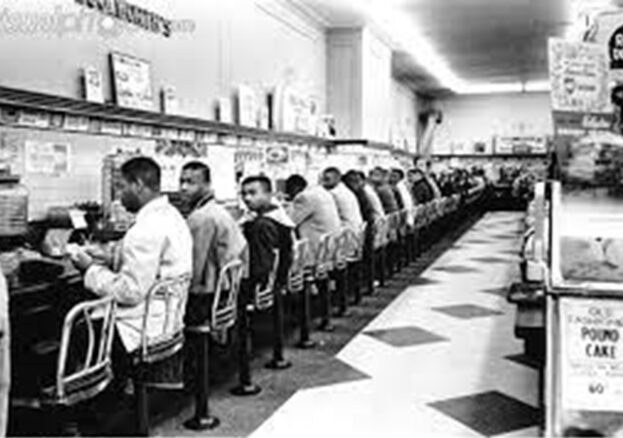
As we honour Black History Month in the USA, it is essential to delve into the impactful events of the Civil Rights Movement. From a British perspective, examining the American fight against racial injustice provides not only a historical understanding but also insights into the global struggle for civil rights. The Sit-ins and Freedom Rides of 1960-1961 stand out as exemplary demonstrations of nonviolent resistance, pivotal in advancing the cause of racial equality in the United States.
Sit-ins: A Bold Statement of Nonviolent Resistance
The sit-in movement began in early 1960 when four African American college students in Greensboro, North Carolina, sat at a segregated Woolworth’s lunch counter, refusing to leave after being denied service. This peaceful form of protest quickly spread across the country, becoming a powerful method for challenging racial segregation in public facilities. The sit-ins demonstrated the strength of nonviolent direct action and played a crucial role in desegregating public spaces.
Expanding the Movement: Student Involvement and Wider Impact
The sit-ins mobilised a large number of young people, particularly students from historically black colleges and universities. This involvement marked a significant shift in the civil rights movement, as it highlighted the power and effectiveness of student-led activism. The movement led to the formation of the Student Nonviolent Coordinating Committee (SNCC), which became a major force in the civil rights struggle.
Freedom Rides: Challenging Segregation in Interstate Travel
In 1961, the Freedom Rides commenced as an initiative to desegregate interstate transportation in the South. Organised by the Congress of Racial Equality (CORE) and later joined by SNCC, groups of black and white activists rode buses into the segregated southern United States to challenge non-enforcement of Supreme Court rulings that segregated buses were unconstitutional. The riders faced brutal violence from segregationists, yet their determination and suffering garnered national attention and sympathy.
The Wider Significance and British Reflections
These acts of defiance had far-reaching implications, not only in the context of American civil rights but also as global symbols of the fight against oppression. In Britain, these movements provide a poignant reminder of the power of collective, nonviolent action and the ongoing struggle for racial equality worldwide.
Educational Implications and Lessons for Future Generations
In the UK, the narrative of the sit-ins and Freedom Rides offers valuable lessons in history, civil rights, and the principles of nonviolent protest. These events are critical in educating young people about the importance of standing against injustice and the effectiveness of peaceful protest.
Contemporary Relevance and Ongoing Struggle
The legacy of the sit-ins and Freedom Rides remains relevant today, as issues of racial discrimination and inequality persist globally. These movements remind us that the pursuit of justice and equality often requires courage, resilience, and collective action.
The sit-ins and Freedom Rides of 1960-1961 are not merely historical events; they are enduring symbols of the fight for racial justice. As we reflect on their impact, we are inspired by their example to continue the struggle for a more equitable and just society. Their legacy challenges us to uphold the ideals of equality and to remain steadfast in the face of injustice.
